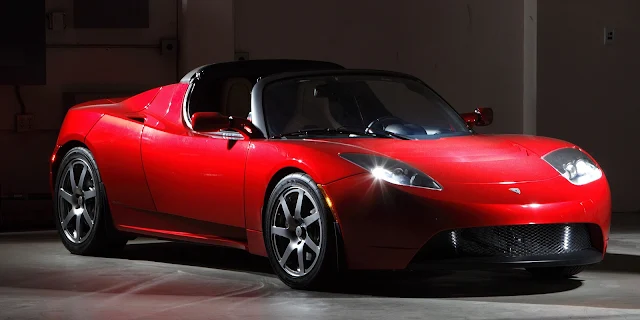Tesla Roadster
 |
| image is taken from roadandtrack.com |
Tesla Roadster: OVERVIEW
Automobile aficionados have rightly started to worry about the future due to growing petrol prices and the unavoidable decline in the world's oil resources. The present "arms race" between high-powered performance automobiles under the hood, according to many, is one final gas-guzzling hurrah before horsepower ratings fall and acceleration times skyrocket.
Fortunately, the 2008 Tesla Roadster proves that sports cars can survive without oil. The Roadster is both straightforward and intricate at the same time. It offers exceptional acceleration in the drama-free manner of a golf cart and the precise handling one would anticipate from a chassis designed by Lotus.
The Tesla Roadster experienced significant setbacks on the way to production after being formally revealed as a concept car in July 2006. This small San Carlos, California-based company kept delaying the car's release date, which worried customers who had paid deposits to reserve their Roadsters.
Thankfully, the final Roadster model has shown to be the real deal. Owners are treated to the Tesla's unique combination of supercar speed and sailboat sound levels at an admittedly high price (almost $100,000 to start), not to mention a distinct sense of superiority every time they drive past a gas station.
Since the invention of the automobile, all-electric vehicles have existed, but their performance and range have suffered significantly when compared to those of gas-powered vehicles.
The Tesla Roadster's cutting-edge battery pack is its secret weapon. The enormous battery pack's lithium-ion composition (which no hybrid car has yet) includes liquid cooling, safety fuses, and advanced programming to provide safe and dependable operation. It offers an operating range of more than 200 miles and acceleration capabilities on par with the top sports vehicles in the world.
The Tesla Roadster is really a restyled Lotus Elise, which explains why it looks strangely familiar. However, Tesla stands out due to various subtle distinctions.
The weight distribution of the Roadster is even more rear-biased than that of the Elise (35 percent front/65 percent rear versus 39/61 for the Lotus) due to its electric motor and battery pack placement.
Almost all of the Roadster's parts are unique; Elise's windshield, mirrors, dashboard, some front suspension parts, and removable soft top are essentially the only ones that aren't.
All that high-tech equipment does add some weight; the Roadster's curb weight of 2,690 pounds is over 800 pounds higher than the Elise's. However, the electric motor has 248 horsepower, which is a record for an Elise.
The Roadster's torque delivery is perhaps most astonishing; its maximum output of more than 200 pound-feet is available as soon as you push the "electricity pedal" from a stop. The Tesla Roadster gives forward-thinking enthusiasts a brand-new method to go quickly thanks to its single-speed transmission and sky-high 13,500 rpm redline.
Additionally, the environment benefits. The Roadster doesn't emit any emissions on its own, but electricity generated by coal- or gas-fired power plants does release some pollutants in the process. However, Tesla asserts that due to the Roadster's extreme efficiency, its associated carbon dioxide emissions would be just approximately a third of those of a common hybrid vehicle.
This innovative methodology does, of course, have certain flaws. The biggest one is its high cost, which only allows the wealthiest customers access. The Roadster's short range is another drawback. The EPA forecasts that even when driven carefully, the Tesla will only be able to travel roughly 220 miles between charges, which is still admirable for an electric vehicle.
Last but not least, the car's Lotus-derived design has several intrinsic flaws, such as manual steering and difficult entry and departure. Nevertheless, as the first true high-performance electric vehicle, the 2008 Tesla Roadster has cemented its position in automotive history. The "trickle-down effect" should eventually allow more enthusiasts to access this winning combo.
Tesla Roadster: Performance
A three-phase, four-pole electric motor that produces 248 horsepower and 211 lb-ft of torque is installed in the Tesla Roadster. The Roadster's motor will initially be coupled to a two-speed electric-shift manual transmission, but the first gear will be locked out because of the system's inability to handle the engine's enormous low-end torque.
Tesla will unveil "Powertrain 1.5" later this year, which incorporates a brand-new one-speed transmission. For owners of the original two-speed vehicles, Tesla will provide a free retrofit of the Powertrain 1.5 modifications.
Two-speed Roadsters can still accelerate from 0 to 60 mph in about 5.7 seconds even when forced to shift into second gear, although this is much slower than the company's aim of about 4.0 seconds. With Powertrain 1.5, Tesla promises that the Roadster will be able to accelerate from a standstill to 60 mph in as little as 3.9 seconds.
Tesla Roadster: Safety
The 2008 Tesla Roadster comes equipped with traction control and antilock brakes as standard safety measures. Notably, there are no side airbags.
Tesla Roadster: Interior
Except for certain unique materials, a redesigned transmission tunnel that houses the Roadster's distinctive shifter, and an information panel that shows battery charge and anticipated cruising range, the inside of the Roadster is essentially identical to that of the Elise. The instruments, sun visors, and steering wheel are all very small.
Although the footwells are incredibly narrow and the seats are comfortable but constricting, at least there is no clutch to worry about. You can understand the concept by picturing a really, really excellent go-kart.



No comments:
Post a Comment